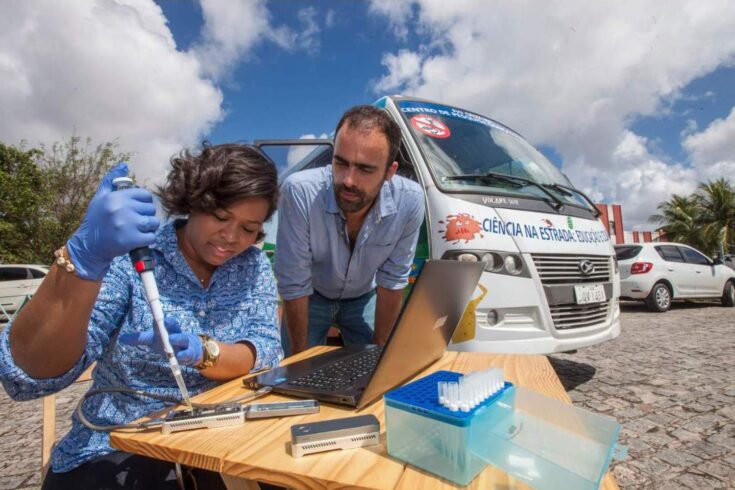Successful healthcare innovations often build on decades of research and substantial industry investment. Nanopore sequencing, a major breakthrough in genomics and biotechnology, came out of pioneering research funded by the MRC and others.
Nanopore sequencing is a ‘next generation’ DNA sequencing technique that uses a doughnut-shaped protein whose hole is just a billionth of a metre (a nanometre) wide.
These tiny pore proteins perforate cell membranes, and nanopore sequencing detects the molecules that go through its inside channel.
About the project
Nanopore sequencing is only possible because of a multitude of discoveries and advancements over the past decades, several of them supported by MRC funding.
Discovering the structure of DNA
Early strategic investment by the MRC led to the setting up of two new research units in London and Cambridge to study the structure of biological molecules. Scientists at these research units discovered the structure of DNA and were awarded the Nobel Prize in 1962.
Development of DNA sequencing
In 1975 Dr Fred Sanger and colleagues at the MRC Laboratory of Molecular Biology developed a new method for rapid sequencing of DNA. Using this method, the team sequenced a bacteriophage virus, which was the first fully sequenced DNA based genome. The Sanger method for DNA sequencing won a Nobel Prize and was instrumental to the successful progress of the Human Genome Project.
Development of nanopore sequencing
The development of a commercial nanopore sequencing device can be traced to discovery science in the 1980s, and in particular Professor Hagan Bayley’s research. In 2003 Professor Bayley moved to the UK and continued his research at the University of Oxford, supported by funding from the MRC and other research councils.
In 2005, the spin-out company Oxford Nanopore Technologies was formed to support and further translate this research into applications in sequencing.
The MinION sequencer
Oxford Nanopore Technologies has developed the MinION sequencer, a $1,000 DNA sequencer the size and weight of a chocolate bar that performs nanopore-based sequencing in just a few hours.
For comparison, a DNA sequencing machine produced by a rival company using different technology is the size of a washing machine and costs about $750,000.
The handheld MinION sequencer makes it possible to move diagnostic testing from the laboratory to ‘point of care’ at the patient’s bedside.
Impacts of the project
The inexpensive handheld DNA sequencing device provides clear advantages, and has already delivered impact in several areas.
Tracking Ebola
In 2013 an outbreak of Ebola virus spread through Guinea, followed by neighbouring Liberia and Sierra Leone. A team of researchers, part-funded by the MRC, deployed the handheld nanopore sequencers in the affected areas to monitor the virus’ response to vaccines and treatment. The pilot project demonstrated that real-time genomic surveillance can be used to guide control measures in resource-limited settings.
Zika virus surveillance
In 2016 the World Health Organization declared the Zika virus, linked to brain damage in thousands of babies in South America, an international public health emergency. A UK and Brazil collaboration, part-funded by the MRC Zika Rapid Response Initiative, used the MinION sequencer to successfully sequence the Zika virus directly from clinical samples. The project shows how portable nanopore sequencing can address emerging global epidemics through mobile real-time surveillance of the virus.
Bedside test for tuberculosis
Tuberculosis is one of the top ten causes of death worldwide. Scientists from the University of Oxford are testing the use of nanopore sequencing technology to determine the presence of Mycobacterium tuberculosis in a clinical sample in less than 24 hours. In 2017 the team won seed funding from the Longitude Prize Discovery Award for this diagnostic approach using the nanopore sequencer.
Nanopore sequencing in personalised medicine
The speed, accuracy, and portability of nanopore sequencing can also transform personalised medicine (tailored to people’s individual health needs), for example in the study of cancer. Tumour samples can be routinely sequenced to identify key driver mutations and then targeted with treatments that can specifically kill the cancerous cells while leaving the healthy cells unharmed. Monitoring the evolution of cancer also becomes easier with cheaper, faster genomic sequencing.

